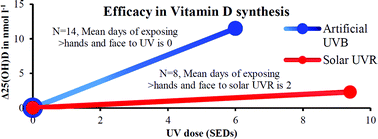Increase in serum 25-hydroxyvitamin-D3 in humans after solar exposure under natural conditions compared to artificial UVB exposure of hands and face†
Abstract

- This article is part of the themed collection: Vitamin D update
* Corresponding authors
a
Department of Dermatology, Copenhagen University Hospital, Bispebjerg, Bispebjerg Bakke 23, 2400 Copenhagen, NV, Denmark
E-mail:
Pameli@mail.dk
Tel: (+45) 35 31 62 73
b Department of Clinical Biochemistry, Lillebaelt Hospital, 7100 Vejle, Denmark
c Danish Meteorological Institute, Lyngbyvej 100, 2100 Copenhagen O, Denmark

 Please wait while we load your content...
Something went wrong. Try again?
Please wait while we load your content...
Something went wrong. Try again?
P. Datta, M. K. Bogh, P. Olsen, P. Eriksen, A. V. Schmedes, M. M. Grage, P. A. Philipsen and H. C. Wulf, Photochem. Photobiol. Sci., 2012, 11, 1817 DOI: 10.1039/C2PP25093D
To request permission to reproduce material from this article, please go to the Copyright Clearance Center request page.
If you are an author contributing to an RSC publication, you do not need to request permission provided correct acknowledgement is given.
If you are the author of this article, you do not need to request permission to reproduce figures and diagrams provided correct acknowledgement is given. If you want to reproduce the whole article in a third-party publication (excluding your thesis/dissertation for which permission is not required) please go to the Copyright Clearance Center request page.
Read more about how to correctly acknowledge RSC content.
 Fetching data from CrossRef.
Fetching data from CrossRef.
This may take some time to load.
Loading related content
